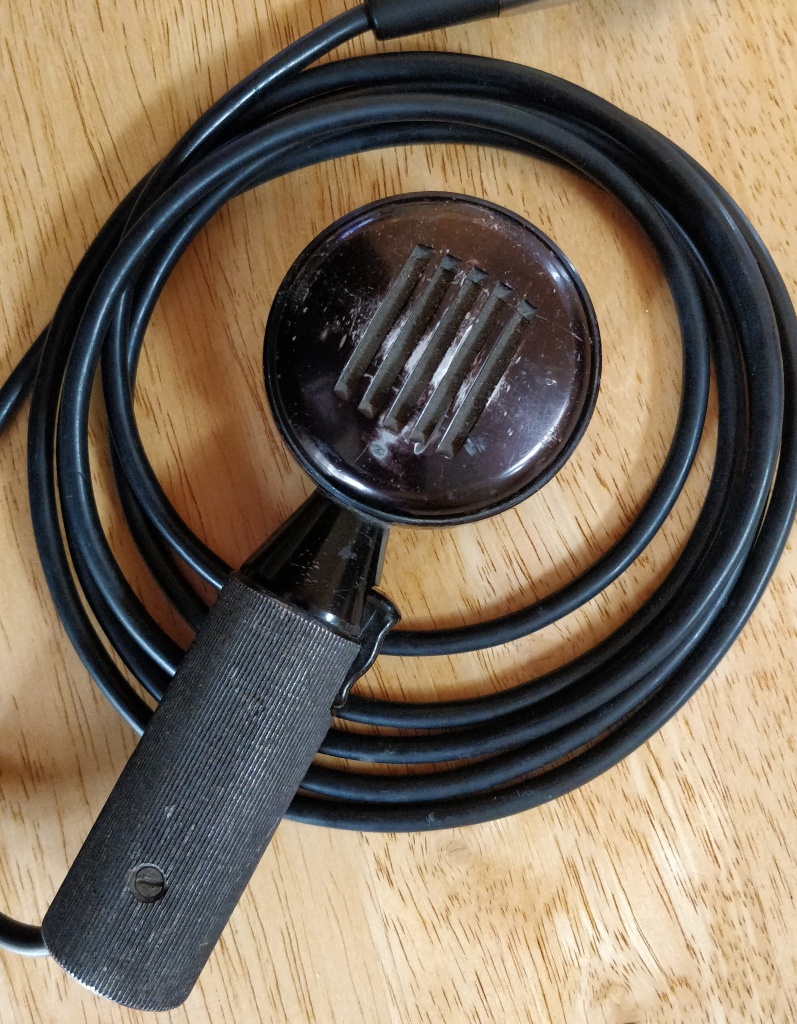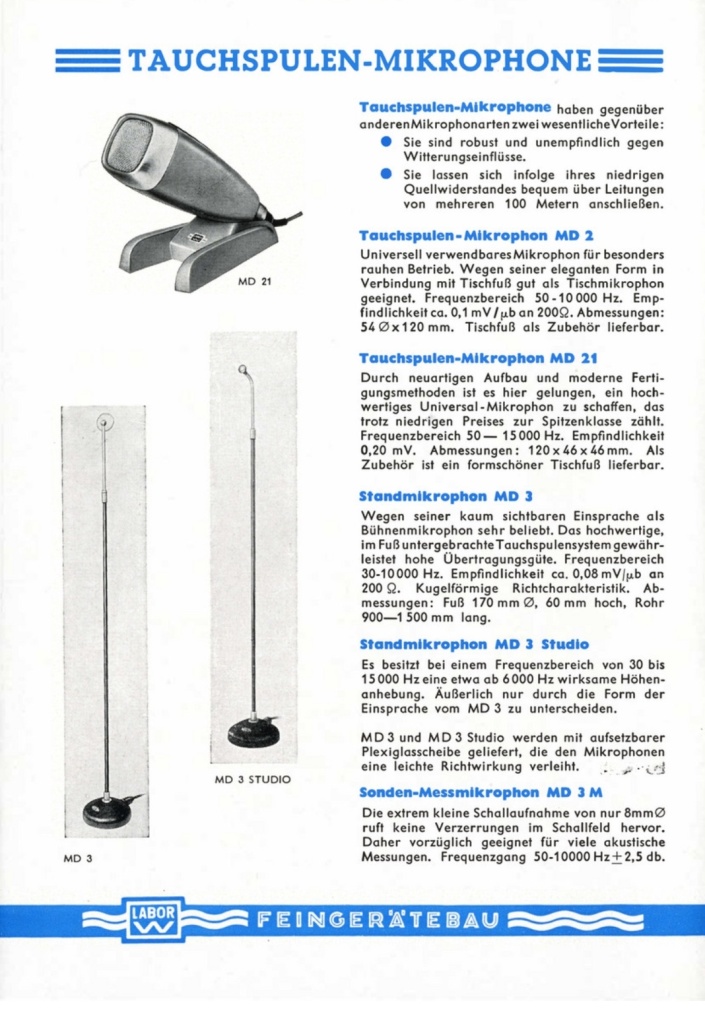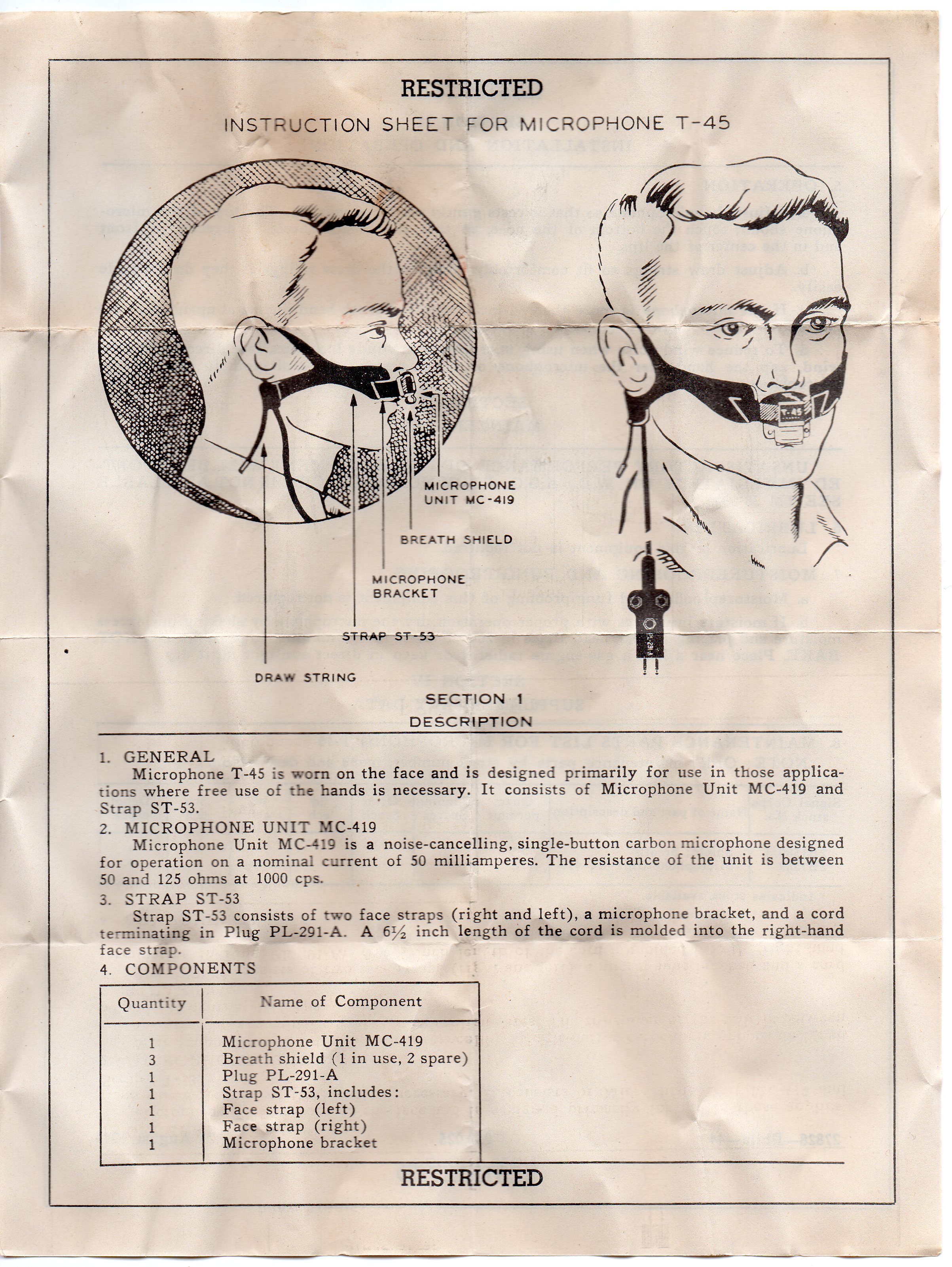Following on from my posts about the LABOR W MD7 and the MD21, here is another gem from the early years of Sennheiser. Released in 1951, the MD4 is an unusual looking, handheld, noise-cancelling, dynamic microphone designed to suppress feedback and ambient noise.
So How Does It Work?
The MD4 is side addressed. Sound can enter through the openings on either side of the capsule. When the user is speaking in close proximity to the front of the microphone their voice is strongly reproduced and very little sound is entering at the back of the diaphram. On the other hand, unwanted sound arriving at the microphone from further away, and in particular at the sides, will enter front and back simultaneously. Bearing in mind that the back of the diaphragm is 180 degrees out of phase with the front, these sounds will be cancelled in varying degrees. This capsule design achieved a considerable degree of off-axis rejection, making it much less likely to pick up unwanted sound from PA loudspeakers or other sources.
Outside of the military and commercial aviation, the MD4 was the first purpose designed, dynamic, noise-cancelling microphone that I can think of, on sale for domestic use.
N.B. Sadly the original Grosse Tuchel connector has gone missing but at some point I will replace it. For now it works fine direct wired.
In a market previously dominated by feedback-prone omnis, the MD4 gained considerable popularity for use in public address and continued in production until 1973. Although initially intended for use with speech the MD4 also found favour as a vocal mic.
Here is the legendary Sonny Boy Williamson II pictured at a folk/blues festival in Germany in 1963.
So what does it sound like?
Here is a Voice Recording Demonstrating the Noise-Cancelling properties of the MD4
And now for something completely different ………….
Close-Mic’d Guitar Amp
N.B. In the context of a live gig the noise-cancelling properties of the MD4 will provide considerable isolation from other performers.
Below is some technical information on the MD4 from the 1953 LABOR W catalogue.
English Translation
Moving coil microphones
Moving coil microphones have two major advantages over other types of microphones:
- They are robust and insensitive to weather influences.
- Due to their low source resistance, they can be easily connected via lines of several 100 metres.
Moving coil microphone MD 2
Universally usable microphone for particularly rough operation. Well suited as a table microphone because of its elegant shape in combination with a table base. Frequency range 50-10,000 Hz. Sensitivity approx. 0.1 mV/ub at 200 . Dimensions: 54 Ø x 120mm. Table base available as an accessory.
Moving coil microphone MD 21
Thanks to a new design and modern production methods, we have succeeded in creating a high-quality universal microphone that, despite its low price, is top class. Frequency range 50-15,000 Hz. Sensitivity 0.20 mV. Dimensions: 120 x 46 x 46 mm. An elegant table base is available as an accessory.
Stand microphone MD 3
Very popular as a stage microphone because of its barely visible input stage. The high-quality moving coil element housed in the base ensures high transmission quality. Frequency range 30-10,000 Hz. Sensitivity approx. 0.08 .V ub and 200 Ω. Spherical polar pattern. Dimensions: base 170 mm Ø, 60 mm high, tube 900-1 500 mm long.
Stand microphone MD 3 Studio
In a frequency range of 30 to 15,000 Hz, it has an effective treble boost from around 6,000 Hz. Externally, it can only be distinguished from the MD 3 by the form of the input stage.
MD 3 and MD 3 Studio are supplied with an attachable Plexiglass panel, which gives the microphones a slight directivity.
Probe measurement microphone MD 3 M
The extremely small sound absorption of only 8 mm Ø does not cause any distortions in the sound field. Therefore particularly suitable for many acoustic measurements. Frequency response 50-10,000 Hz + 2.5 db.
Moving coil microphones (page 2)
Table microphone MD 3 T
A particularly elegant table microphone for first-class transmission of speech and music. Base plate can be unscrewed and has a thread suitable for mounting on a photographic tripod. Balanced frequency range 50 -10,000 Hz. Sensitivity 0.08 mV/ub at 200 Ω. Omnidirectional polar pattern. Dimensions: ball 60 mm Ø, plate 70 mm Ø, projection 450 mm.
Hand microphone MD 4
The MD4 has proven to be excellent for all voice transmissions where there is a risk of acoustic feedback. Through particularly effective compensation, any sound coming from a greater distance is very strongly suppressed. The MD4 is therefore just as suitable for transmissions from very noisy rooms. Frequency range 50-10,000 Hz. Internal resistance 200Ω. Voltage emitted during normal discussion 4mV. Dimensions: case 60 mm Ø, length 180 mm, weight 380 g. – The MD4 is available with a talk switch and also in a switchable high-impedance version.
Hand microphone MD 42
Field of application like MD4; but is end addressed. Frequency range 200-10,000 Hz. Internal resistance 200Ω. Voltage emitted during normal discussion 2.5 mV. Dimensions 47mm Ø. Length 120 mm, weight approx. 135 g.
Moving coil microphone MD 5
Universally usable microphone in a favourable price range. Can be used as a hand, table or tripod microphone. Excellent reproduction, especially for voice transmission. Available in low and high resistance, with and without a switch. Sensitivity approx. 0.25 mV/ub or 7mV/ub. Dimensions: 86 x 65 x 52 mm.
Speech microphone MD 7
Particularly good speech intelligibility due to emphasis on high frequencies. Therefore recommended for announcement and dictation systems. The soft rubber housing makes the MD7 insensitive to rough use. Available in low-impedance and high-impedance versions. Dimensions: 76 x 48 x 48 mm.
Microphone Accessories
Tripods, flexible necks, table bases, cables, couplings in various designs available.
Conclusion
Throughout the decade following the establishment of LABOR W in June 1945 Fritz Sennheiser and his colleagues at Laboratorium Wennebostal worked hard producing a range of innovative microphones for a variety of purposes, aimed at different sectors of the market. They offered microphones for the home, the office, the stage, journalism and TV and sound studios. As we can see from the catalogue above they demonstrated a remarkable degree of ingenuity, technical expertise and creativity. These are characteristics which distinguish the Sennheiser brand to this day.
Credits
Many thanks to my old school friend Alan Marchant for kindly donating this fascinating microphone. Alan is owner of The Vintage Wireless Co in Manchester at 174 Cross St, Sale M33 7AQ. His shop is an amazing Aladdin’s cave of ancient wirelesses, car radios, gramophones and phonographs. Well worth a visit!
Thanks also to Keith Thompson for sparing the time to record the tasty blues guitar clips.
And thanks to Hazel Hanson for the English translation of the LABOR W Catalogue.















